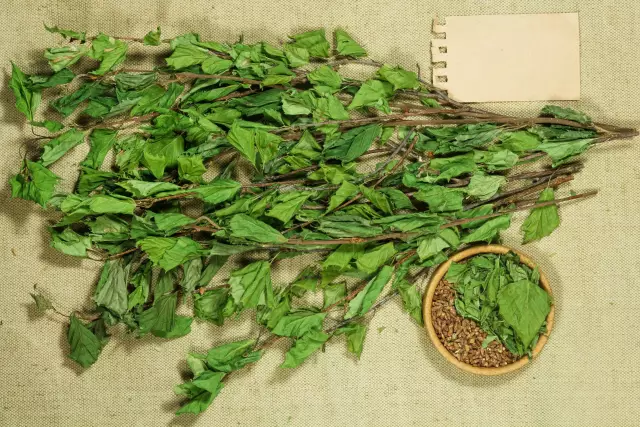- Author Rachel Wainwright [email protected].
- Public 2023-12-15 07:39.
- Last modified 2025-11-02 20:14.
White birch
Instructions for use:
- 1. Application and action
- 2. Harm

A prominent representative of the birch family is white birch - a tree that grows up to 20 m in height. It has a smooth, parchment-like white bark with dark characteristic lines. Most often, the tree grows wild, but can be cultivated as a greenery, ornamental plant. There are approximately 120 species of birch in the world, with 65 of them growing in Russia. All types of birches differ from each other only in some signs; they are used in medicine in exactly the same way.
White birch is widespread in the forest-steppe and forest zone of Siberia and the European part of Russia. The plant is a melliferous plant, bees are especially fond of birch sap, which can be collected even from birch sawdust. The flowering period is May.
The following parts of white birch are used for different purposes:
- Kidneys, which are harvested during the swelling period (i.e., in March-April);
- Leaves gathering at the very beginning of flowering;
- Wood and bark;
- Birch sap, which is harvested in early spring.
Birch buds and leaves are known for their phytoncidal properties. The composition of birch sap is characterized by the presence of glucose, fructose, protein and malic acid.
Application and action
A decoction (or infusion) of white birch buds has excellent antiseptic, diuretic and choleretic properties. As a result of studies, a significant increase in urination was noted precisely under the influence of such a decoction, as well as a dramatic decrease in various edema, even if other diuretics or cardiac drugs were ineffective. The properties of birch buds make it possible to use tincture of them for the treatment of chronic and acute forms of eczema, skin erosion, various kinds of wounds, bedsores, etc.
A decoction (or infusion) of birch leaves is widely used as an effective diuretic. Thanks to research by scientists in recent years, it has become known that a significant increase in urination occurs precisely under the influence of infusion from birch leaves (excretion increases from 400 ml to 2500 ml), shortness of breath also decreases, edema disappears. Infusion of young birch leaves can be used as a stimulant for jaundice, renal colic, various disorders of the nervous system. In addition, this infusion is an excellent vitamin and anti-inflammatory agent.
In Bulgaria, white birch leaves are used as a potent diuretic for the treatment of atherosclerosis, rheumatism and kidney disease.
The simplest leaf decoction is prepared according to the following technology: pour 500 ml of boiling water with 6-8 g of leaves, then boil this mixture for about 15-20 minutes, then strain and take it regularly throughout the day. Birch buds are also applied to areas of diseased joints. They also make special baths from decoctions of birch leaves.
There is a special birch activated carbon called "carbolene", it is used as an adsorbent for poisoning with bacterial toxins and poisons. With dyspepsia, flatulence, dysentery, birch charcoal is shown, carefully crushed into powder. This charcoal is also a good antispasmodic agent.
Birch tar also has a bactericidal effect, which is obtained by the method of dry distillation of the bark (it is part of the famous Vishnevsky ointment, which is used as a remedy for wound healing, as well as Wilkinson's ointment, used to treat scaly lichen and scabies).
In France, birch is called the "tree of wisdom", and its young leaves, buds, sap and root are used for medicinal purposes:
- Birch buds, the properties of which are quite multifaceted, are used in the form of an extract;
- Birch leaves are used in the form of an infusion that has a calming and stimulating effect (recommended for jaundice and renal colic);
- White birch root is used as an anti-febrile and anti-rheumatic agent;
- Birch sap is a refreshing and healthy drink.
The Swedes make homemade beer from the second layer of wood, the Germans and Austrians use young birch leaves as a good choleretic and diuretic, while the inhabitants of Poland use young white birch leaves to treat dropsy, neuroses, kidney inflammation and many other diseases.
The properties of birch leaves are exactly the same as those of birch buds, but to a lesser extent. Baths of fresh leaves of white birch are recommended for gout and articular rheumatism, in which it is also advised to make compresses from steamed dry or fresh leaves. Compresses made from birch leaves are no less useful for burns, bedsores, and excessive sweating of the legs.
Birch sap, which has general tonic and diuretic properties, is used for arthritis, gout, scurvy, edema, anemia, trophic ulcers, long non-healing wounds, sore throat, furunculosis.
In the treatment of scrofula, ulcers and wounds, the bark of white birch is used, but in the fight against scabies and leprosy, birch tar is used. For gonorrhea, special birch oil is used, extracted by distillation from birch buds.
The properties of birch are also actively used in the perfumery industry, and the juice of this tree is included in various drinks.
Harm
Due to the irritating effect of white birch buds, the use of decoctions and tinctures is possible only under the supervision of a physician. Their long-term use is strictly prohibited.
Information about the drug is generalized, provided for informational purposes only and does not replace the official instructions. Self-medication is hazardous to health!






